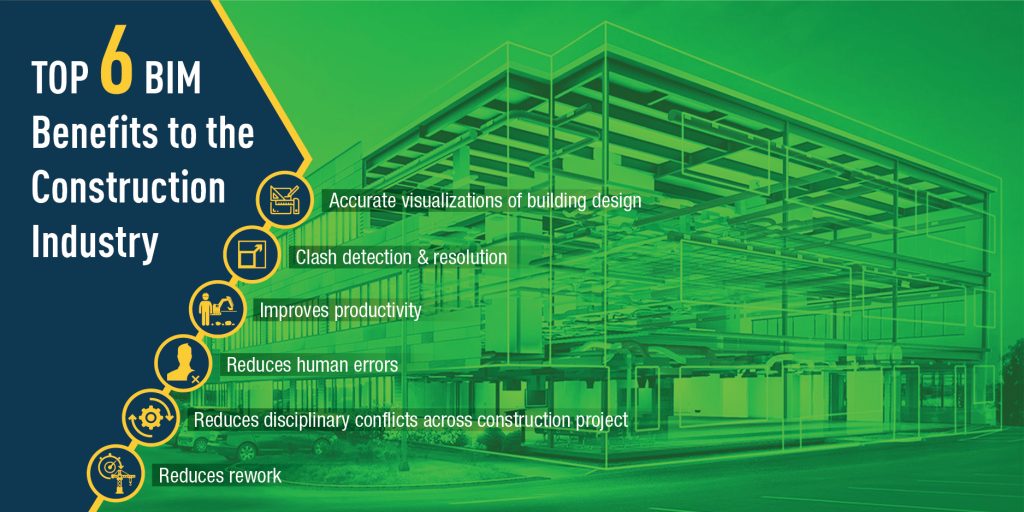AEC fraternity is aware that Building Information Modeling (BIM) enhances efficiency and users are bestowed with several benefits. BIM users have realized the potentials of BIM in form of cutting down on the rework by re-keying information into BIM ready 3D models or making changes on the construction site. However; the question has been doing rounds since inception, whether BIM benefits are more for BIM professionals or for the overall building construction industry. To start with, we would see how do BIM benefits, which will be followed with its benefits to BIM professionals and then to overall construction industry.
How Does BIM Help?
BIM is an alternative to conventional CAD strategies. It delivers a number of advantages of the ability to graphically display information for design and development. BIM is not simply a technology, but rather a process used to support the design, construction, or management of a design or renovation project. Though the technology is available on various platforms, it successfully supports both, architectural tools and in incorporating information intelligence as a part of the 3D BIM modeling process.
Top benefits of BIM include:
- BIM Reduces Rework happens to be the highest rated business benefit, if BIM experts are to be believed. BIM has the potential to take high to very high – if utilized appropriately; though beginners or small and medium sized AEC firms are of a different belief altogether.
- BIM Improves Productivity is ranked highest by architects as it is the best way they succeeded in improving their return on investment from technology perspective.
- BIM Reduces Conflicts and Changes across construction process are the top ways engineers believe that BIM does value addition to their construction projects.
- Clash Detection and Avoiding Rework has helped owners to save time and money, through BIM usage
Various other benefits of BIM go beyond simple 3D modeling:
- Earlier and more accurate visualizations of a design
- Reduction in human error
- Extract cost estimates
- Generate accurate and consistent 2D Drawings at any stage
- Integration between analysis/design model and construction model
- More efficient construction phasing
- Improved planning and resource allocation
- Discover design errors before construction (clash detection)
- Aids clearer communication to all stakeholders
- Quicker and easier design revisions
- Collaboration of multiple design disciplines
- Reduction of waste
- Further analytical design
- Improved facilities Management
From Level 0 as unmanaged CAD, to Level 1 as a mix of 2D and 3D information, Level 3 is supposedly a big step in the digital built strategy and is defined in four distinct delivery phase scales:
- Level 3A Enabling improvements in the Level 2 model;
- Level 3B Enabling new technologies and systems;
- Level 3C Enabling the development of new business models;
- Level 3D Capitalizing on world leadership.
So now coming to the point; whether BIM is more beneficial for Building construction professionals or for the overall building construction industry?
Benefits of BIM to Building Construction Professionals
BIM professionals who form a part of the design and construction process are benefited from BIM; but their views on which team gets more value is really interesting to know about:
- Architects efficiently & accurately create, document, and share design visions with BIM
BIM evolved with architects, hand in hand. It enables architects and designers to create and communicate design intent and understand performance, appearance, and cost early in the building design process. With help of software like Autodesk Architecture, architects can easily capture and analyze design concepts more accurately, while maintaining coordinated and reliable design data through documentation and construction. May be that is the reason why a lot of them still see its value emerging from the use of BIM in the design phases. Most architects, if not all, in the design community; along with contractors and owners say that they have experienced value addition to their construction projects. - Structural engineers design, visualize, simulate, document, and build with BIM
Half of the BIM users agreed that structural engineers can reap maximum BIM benefits. Elements such as steel columns, beams and trusses are more than often modeled by BIM users. Not only structural engineers, but detailers and fabricators as well; in order to improve structural design documentation, minimize errors, and streamline collaboration between teams opt for Autodesk BDS. It has the power of BIM with Autodesk Revit & Autodesk 3ds Max. Construction contractors are the ones who most likely see structural engineers realizing significant BIM benefits. - Construction Managers, General Contractors and Model based BIM
Money can be either spent largely or saved immensely during any construction project. Reducing re-work has proved its worth in keeping the budgets really low. General contractors use BIM based simulations and renderings for presentation to their clients. With help of Autodesk Navisworks for clash detection, and 4D BIM simulations for MEP validation and BIM coordination, contractors experience reductions in direct schedules, increased productivity and direct cost reductions. Owners see general contractors gain high value on any BIM implemented construction project, mostly due to the reason that savings done are passed on to the stakeholders. - Fabricators use model based design and digitized fabrication with BIM
BIM reduces conflicts, bringing about confidence in building plans; there are BIM users who see opportunities for value addition in fabrication as well. Fabrication of materials done accurately reduces waste and simultaneously saves time with help of pre-assembly. Revit structure boosts the structural fabrication process by feeding all geometrical information about the structural steel in the Revit Structure design model. Contractors see fabricators experiencing higher value addition as compared to architects, engineers and owners. - MEP Engineers are maximizing streamlined Workflows with BIM
MEP engineers have wide range of opportunities to capitalize on BIM benefits. Modeling of larger elements such as duct systems and air handlers are amongst the options available; whereas smaller elements including electrical switches and outlets are a bit challenging. Autodesk Revit MEP used for MEP engineering deliver accurate and time-saving solutions to MEP teams. Very few engineers believe in reaping high value from BIM, but at the same time more than half of the contractors believe that MEP engineers can benefit significantly with help of BIM. - Owners
Owners are the ones who ultimately experienced overall value addition in form of high value. BIM helps owners and operators gain efficiencies throughout the lifecycle of a building project – from design and construction stages through to occupancy – for improved facility management and O&M. It could be due to the reason that other teams believed that owners are just half way, and more is for them to attend to when it comes to operations and maintenance of buildings. However; most of the owners believe they can rely on the value of BIM during design and construction. - Specialty Contractors
Though specialty contractors are held responsible for execution of complexities in any construction project, other teams believe they are experiencing high value from BIM. Sub-contractors are small or medium sized firms if compared to general contractors. They are the ones for whom the cost of BIM adoption could be really prominent and expense. BIM users put at task a wide range of software applications, subcontractors are likely to face interoperability challenges, inviting unwarranted expenses to work within various models. - Building Product Manufacturers
Autodesk Revit Family Creation software proves its worth in importing product models from widely used CAD tools. It opens up new revenue opportunities by focusing on developing smart, connected building products.
Benefits of BIM to overall Building Construction Industry
BIM users encounter various opportunities to realize BIM values.
Productivity challenges, such as reduced rework and errors, are looked upon at more beneficial as again the value benefits of BIM; as these are directly related to time savings and cost reduction. This also is a proof that users across all levels of BIM see it as one helping them to work better. However; cost savings here also has taken the front seat and more likely to be realized by experienced users.
Enlisted are some of the top rated benefits of BIM to overall building construction industry:
- BIM Marketing
BIM has opened up doors for companies to deliver new business to new clients across the construction environment. Increased number of clients requiring BIM on jobs, results in increased number of team members equipped with BIM skills to capture that business. On other hand, there are possibilities that design support service providers can introduce the BIM technology to newer clients, and use it as a marketing feature to land up a project in the bid. - Project Outcome
More than half of the owners are of the opinion that BIM’s impact on their overall project performance and outcome is highly beneficial to them. However; BIM experts differ to this and say that reduced problems, improved client relationships, etc., are more beneficial. - Reduced Errors
Particularly contractors see reduced errors and omissions in the construction documents, as one of the significant benefits that they gain. They strongly feel that virtual design and construction with BIM creates the potential to identify problems earlier in the building process. - BIM New Services
BIM can be and is being utilized as a new way to bring new offerings to an old – but experienced business. Several BIM users, after adding BIM to their toolbox, benefited immensely in their practice. This is so very obvious for more recent BIM adopters. Contractors from the design community, who were late in adopting BIM, find benefits of BIM adoption to be very unique and highly beneficial. - Reducing Rework
Fixing problems early means fewer issues in the plans and ultimately fewer hassles in the field. Contractors see the potential of BIM in reducing rework as the top benefit, and also the highest ranked benefit as expressed by expert BIM users.
Conclusion
With passing years, as and when BIM users gain experience and proficiency, the opportunities to enhance and improve the productivity increase. This ultimately will benefit the BIM user, may it be a BIM professional or the industry. It is a must to understand, when industry grows – professionals grow, and professionals can grow – only if the industry grows.
BIM processes have succeeded in helping countless AEC firms to operate more productively, produce higher-quality work, attract more talent, and win new business. With increasing number of government and commercial organizations mandating BIM, it is the right time to implement BIM.







![The Value of Safety [Infographic]](https://lerablog.org/wp-content/plugins/wp-thumbie/timthumb.php?src=http://lerablog.org/wp-content/uploads/2014/12/the-value-of-safety.jpg&w=300&h=140&zc=1)
